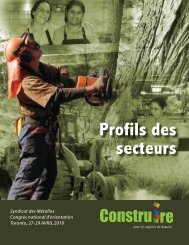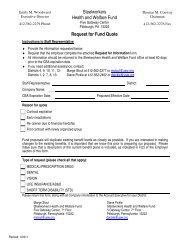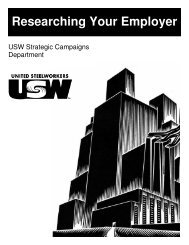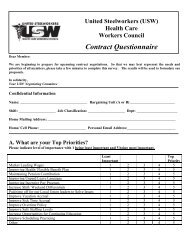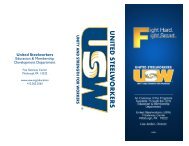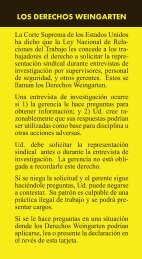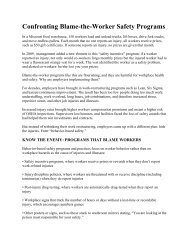Union Approach to Health and Safety: - United Steelworkers
Union Approach to Health and Safety: - United Steelworkers
Union Approach to Health and Safety: - United Steelworkers
Create successful ePaper yourself
Turn your PDF publications into a flip-book with our unique Google optimized e-Paper software.
After 10 minutes, ask someone from each group <strong>to</strong> explain their body map. Each group<br />
should tape their map <strong>to</strong> a wall where it can be seen by all participants.<br />
Ask participants if they notice any patterns of injuries or illnesses emerging – either on a<br />
particular group’s body map or on all of the body maps taken <strong>to</strong>gether. Have them<br />
identify the kinds of injuries <strong>and</strong> illnesses that appear <strong>to</strong> be the most common.<br />
Tell participants that behind every dot is a hazard or condition that needs <strong>to</strong> be fixed.<br />
Ask participants <strong>to</strong> think about the hazards <strong>and</strong> workplace conditions that caused these<br />
injuries <strong>and</strong> illnesses. The next step is <strong>to</strong> identify those hazards <strong>and</strong> conditions, <strong>and</strong> their<br />
location in the workplace. Then a plan can be made <strong>to</strong> get these problems corrected.<br />
Hazard/Risk Mapping<br />
A hazard/risk map is a drawing of a workplace or a part of a workplace on which workers<br />
<strong>and</strong> unions identify the hazards <strong>and</strong> unsafe <strong>and</strong> unhealthy conditions that are causing<br />
workers’ symp<strong>to</strong>ms, injuries, illnesses <strong>and</strong> stresses. The union is then able identify<br />
priorities for correction. There is no one who knows more about the hazards <strong>and</strong> concerns<br />
on a job than the workers who confront them every day. This mapping activity gathers<br />
that important experience <strong>to</strong>gether.<br />
To create a hazard/risk map, you need the following materials:<br />
Flip chart paper,<br />
Flip chart markers,<br />
Pages of colored “sticky dots” in six different colors,<br />
Tape, <strong>and</strong><br />
Color code for hazard mapping (this could be a flip chart page, a h<strong>and</strong>out, or both –<br />
see attached example at end of h<strong>and</strong>out).<br />
Tell participants that a hazards/risk map is a map of a workplace or section of a<br />
workplace which shows the location of particular hazards <strong>and</strong> conditions that are causing<br />
(or could cause) workers <strong>to</strong> be injured, made ill or stressed on the job. Hazards/risk<br />
mapping is a <strong>to</strong>ol that can be used by unions <strong>and</strong> workers <strong>to</strong> identify hazards for<br />
correction.<br />
Divide participants in<strong>to</strong> small groups based on their department, workplace or industry. If<br />
participants are all from the same workplace, you can ask participants from the same or<br />
similar departments or job classifications <strong>to</strong> group <strong>to</strong>gether. Or, if participants include<br />
people from the same or similar types of workplaces/industries, they can be grouped<br />
<strong>to</strong>gether. Once participants have been assigned <strong>to</strong> small groups, have each small group<br />
gather around a table or a section of a table.<br />
Distribute the following <strong>to</strong> each small group:<br />
A flip chart page,<br />
A flip chart marker,




